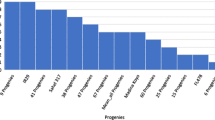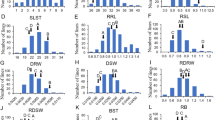Abstract
Salinity is a key abiotic constraint on crop production worldwide. To minimize the effect of salinity on rice production, crop improvement strategies based on molecular marker techniques and genetic engineering are being used to develop salt-tolerant rice varieties. The development of such varieties, however, is hindered by limited parental resources. In this study, Haidao 86 (HD86) was observed to exhibit strong salt tolerance during its entire growth period, suggesting that it is a good donor for breeding salt-tolerant rice varieties. To dissect the molecular characteristics underlying the salt tolerance of HD86, we performed quantitative trait locus (QTL) analysis at the seed germination stage of an F2 segregating population derived from crossing HD86 with Nipponbare under 2% NaCl treatment (EC of 32.90 dS/m). One salt-tolerant QTL, qST1, was identified on the long arm of chromosome 1 between the markers CHR1-30M and CHR1-36M, corresponding to a genetic distance of 17.9 cM, and explained about 9.27% of the phenotypic variance. Using 1500 plants of the HD86 BC4F2 introgression lines in the Nipponbare genetic background with heterozygous segments between markers CHR1-30M and CHR1-36M, the exact location of qST1 was narrowed down to a 900 kb region. Combined with a bulk segregant analysis using two extreme phenotype pools of F2, eleven candidates were predicted among the mapped qST1 region. Quantitative RT-PCR analyses revealed that eleven candidates were differentially expressed in response to salt stress at the germination stage in HD86 compared with Nipponbare, suggesting the possible role of these genes in regulating salt tolerance in HD86.





Similar content being viewed by others
Data Availability
All datasets generated for this study are included in the article/Supplementary Material.
References
Al-Tamimi N, Brien C, Oakey H, Berger B, Saade S, Ho YS, Schmockel SM, Tester M, Negrao S (2016) Salinity tolerance loci revealed in rice using high-throughput non-invasive phenotyping. Nat Commun 7:13342. https://doi.org/10.1038/ncomms13342
Baby JDJ, Sujatha S (2010) Biological and physiological perspectives of specificity in abiotic salt stress response from various rice plants. Asian J Agric Sci 2:90–105
Bimpong IK, Manneh B, Diop B, Ghislain K, Sow A, Amoah NKA, Gregorio G, Singh RK, Ortiz R, Wopereis M (2014) New quantitative trait loci for enhancing adaptation to salinity in rice from Hasawi, a Saudi landrace into three African cultivars at the reproductive stage. Euphytica 200:45–60. https://doi.org/10.1007/s10681-014-1134-0
Bizimana JB, Luzi-Kihupi A, Murori RW, Singh RK (2017) Identification of quantitative trait loci for salinity tolerance in rice (Oryza sativa L.) using IR29/Hasawi mapping population. J Genet 96:571–582. https://doi.org/10.1007/s12041-017-0803-x
Chen R, Cheng Y, Han S, Van Handel B, Dong L, Li X, Xie X (2017) Whole genome sequencing and comparative transcriptome analysis of a novel seawater adapted, salt-resistant rice cultivar—sea rice 86. BMC Genomics 18:655. https://doi.org/10.1186/s12864-017-4037-3
Du H, Yu Y, Ma Y, Gao Q, Cao Y, Chen Z, Ma B, Qi M, Li Y, Zhao X, Wang J, Liu K, Qin P, Yang X, Zhu L, Li S, Liang C (2017) Sequencing and de novo assembly of a near complete indica rice genome. Nat Commun 8:15324. https://doi.org/10.1038/ncomms15324
Ganie SA, Molla KA, Henry RJ, Bhat KV, Mondal TK (2019) Advances in understanding salt tolerance in rice. Theor Appl Genet 132:851–870. https://doi.org/10.1007/s00122-019-03301-8
Ghomi K, Rabiei B, Sabouri H, Sabouri A (2013) Mapping QTLs for traits related to salinity tolerance at seedling stage of rice (Oryza sativa L.): an agrigenomics study of an Iranian rice population. OMICS 17:242–251. https://doi.org/10.1089/omi.2012.0097
He Y, Yang B, He Y, Zhan C, Cheng Y, Zhang J, Zhang H, Cheng J, Wang Z (2019) A quantitative trait locus, qSE3, promotes seed germination and seedling establishment under salinity stress in rice. Plant J 97:1089–1104. https://doi.org/10.1111/tpj.14181
Hossain MR, Pritchard J, Ford-Lloyd BV (2015) Qualitative and quantitative variation in the mechanisms of salinity tolerance determined by multivariate assessment of diverse rice (Oryza sativa L.) genotypes. Plant Genetic Resour 14:91–100. https://doi.org/10.1017/s1479262115000118
Hossain H, Rahman MA, Alam MS, Singh RK (2014) Mapping of quantitative trait loci associated with reproductive-stage salt tolerance in rice. J Agron Crop Sci 201:17–31. https://doi.org/10.1111/jac.12086
Islam MS, Ontoy J, Subudhi PK (2019) Meta-analysis of quantitative trait loci associated with seedling-stage salt tolerance in rice (Oryza sativa L.). Plants 8:33
Jahan N, Zhang Y, Lv Y, Song M, Zhao C, Hu H, Cui Y, Wang Z, Yang S, Zhang A, Hu J, Ye G, Qian Q, Gao Z, Guo L (2020) QTL analysis for rice salinity tolerance and fine mapping of a candidate locus qSL7 for shoot length under salt stress. Plant Growth Regul 90:307–319. https://doi.org/10.1007/s10725-019-00566-3
Jain M, Nijhawan A, Tyagi AK, Khurana JP (2006) Validation of housekeeping genes as internal control for studying gene expression in rice by quantitative real-time PCR. Biochem Biophys Res Commun 345:646–651. https://doi.org/10.1016/j.bbrc.2006.04.140
Khatun S, Flowers TJ (1995) Effects of salinity on seed set in rice. Plant Cell Environ 18:61–67
Li H, Durbin R (2010) Fast and accurate long-read alignment with Burrows-Wheeler transform. Bioinformatics 26:589–595. https://doi.org/10.1093/bioinformatics/btp698
Lin HX, Zhu MZ, Yano M, Gao JP, Liang ZW, Su WA, Hu XH, Ren ZH, Chao DY (2004) QTLs for Na+ and K+ uptake of the shoots and roots controlling rice salt tolerance. Theor Appl Genet 108:253–260. https://doi.org/10.1007/s00122-003-1421-y
Ling QH (2018) Discussion on the related problems of rice planting in saline-alkali soil. China Rice 24:1–2
Lutts S, Bouharmont J (1995) Changes in plant response to NaCl during development of rice (Oryza sativa L.) varieties differing in salinity resistance. J Exp Bot 46:1843–1852
Meksem K, Kahl G (2005) The handbook of plant genome mapping: genetic and physical mapping. Wiley-Vch Verlag GmbH, Weinheim, Germany
Mondal S, Borromeo TH, Diaz MGQ, Amas J, Rahman MA, Thomson MJ, Gregorio GB (2019) Dissecting QTLs for reproductive stage salinity tolerance in rice from BRRI dhan 47. Plant Breeding Biotechnol 7:302–312. https://doi.org/10.9787/pbb.2019.7.4.302
Patnaik S, Misra CS, Bhadrachalam A (1965) Studies on the nutrition of the rice plant (Oryza satvia L.). Proc Indian Acad Sci 61:309–315
Rahman MA, Bimpong IK, Bizimana JB, Pascual ED, Arceta M, Swamy BPM, Diaw F, Rahman MS, Singh RK (2017) Mapping QTLs using a novel source of salinity tolerance from Hasawi and their interaction with environments in rice. Rice 10:47. https://doi.org/10.1186/s12284-017-0186-x
Rahman MA, Thomson MJ, De Ocampo M, Egdane JA, Salam MA, Shah EAM, Ismail AM (2019) Assessing trait contribution and mapping novel QTL for salinity tolerance using the Bangladeshi rice landrace Capsule. Rice 12:63. https://doi.org/10.1186/s12284-019-0319-5
Ren ZH, Gao JP, Li LG, Cai XL, Huang W, Chao DY, Zhu MZ, Wang ZY, Luan S, Lin HX (2005) A rice quantitative trait locus for salt tolerance encodes a sodium transporter. Nat Genet 37:1141–1146. https://doi.org/10.1038/ng1643
Semagn K, Bjornstad A, Ndjiondjop MN (2006) Principles, requirements and prospects of genetic mapping in plants. Afr J Biotech 5:2569–2587
Sharma A, Rana C, Singh C, Katoch V (2016) Soil salinity causes, effects, and management in cucurbits. In: Pessarakli M (ed) Handbook of cucurbits: growth, cultural practices, and physiology. CRC Press, Taylor and Francis Group, pp 419–434
Shi Y, Gao L, Wu Z, Zhang X, Wang M, Zhang C, Zhang F, Zhou Y, Li Z (2017) Genome-wide association study of salt tolerance at the seed germination stage in rice. BMC Plant Biol 17:92. https://doi.org/10.1186/s12870-017-1044-0
Sun BR, Fu CY, Fan ZL, Chen Y, Chen WF, Zhang J, Jiang LQ, Lv S, Pan DJ, Li C (2019a) Genomic and transcriptomic analysis reveal molecular basis of salinity tolerance in a novel strong salt-tolerant rice landrace Changmaogu. Rice 12:99. https://doi.org/10.1186/s12284-019-0360-4
Sun J, Xie D, Zhang E, Zheng H, Wang J, Liu H, Yang L, Zhang S, Wang L, Zou D (2019b) QTL mapping of photosynthetic-related traits in rice under salt and alkali stresses. Euphytica 215:147. https://doi.org/10.1007/s10681-019-2470-x
Takagi H, Abe A, Yoshida K, Kosugi S, Natsume S, Mitsuoka C, Uemura A, Utsushi H, Tamiru M, Takuno S, Innan H, Cano LM, Kamoun S, Terauchi R (2013) QTL-seq: rapid mapping of quantitative trait loci in rice by whole genome resequencing of DNA from two bulked populations. Plant J 74:174–183. https://doi.org/10.1111/tpj.12105
Takagi H, Tamiru M, Abe A, Yoshida K, Uemura A, Yaegashi H, Obara T, Oikawa K, Utsushi H, Kanzaki E, Mitsuoka C, Natsume S, Kosugi S, Kanzaki H, Matsumura H, Urasaki N, Kamoun S, Terauchi R (2015) MutMap accelerates breeding of a salt-tolerant rice cultivar. Nat Biotechnol 33:445–449. https://doi.org/10.1038/nbt.3188
Thomson MJ, Ocampo MD, Egdane J, Rahman MA, Sajise AG, Adorada DL, Tumimbang-Raiz E, Blumwald E, Seraj ZI, Singh RK (2010) Characterizing the saltol quantitative trait locus for salinity tolerance in rice. Rice 3:148–160
Tiwari S, Sl K, Kumar V, Singh B, Rao AR, Mithra SVA, Rai V, Singh AK, Singh NK (2016) Mapping QTLs for salt tolerance in rice (Oryza sativa L.) by bulked segregant analysis of recombinant inbred lines using 50K SNP Chip. PLoS ONE 11:e0153610. https://doi.org/10.1371/journal.pone.0153610
Tsai YC, Chen KC, Cheng TS, Lee C, Lin SH, Tung CW (2019) Chlorophyll fluorescence analysis in diverse rice varieties reveals the positive correlation between the seedlings salt tolerance and photosynthetic efficiency. BMC Plant Biol 19:403. https://doi.org/10.1186/s12870-019-1983-8
Van Ooijen JW (2006) Joinmap 4, software for the calculation of genetic linkage maps in experimental population. Kyazma B.V., Wageningen, Netherlands
Wang S, Basten CJ, Zeng ZB (2007) Windows QTL cartographer 2.5. Department of Statistics North Carolina State University, Raleigh
Wang Z, Wang J, Bao Y, Wu Y, Zhang H (2011) Quantitative trait loci controlling rice seed germination under salt stress. Euphytica 178:297–307. https://doi.org/10.1007/s10681-010-0287-8
Wang Z, Cheng J, Chen Z, Huang J, Bao Y, Wang J, Zhang H (2012) Identification of QTLs with main, epistatic and QTL × environment interaction effects for salt tolerance in rice seedlings under different salinity conditions. Theor Appl Genet 125:807–815. https://doi.org/10.1007/s00122-012-1873-z
Acknowledgements
We thank Mr. Risheng Chen for providing Haidao 86 seeds. We also thank MDPI author service (https://www.mdpi.com/authors/english#English_Editing_Services) for special editing the English text of a draft of this manuscript.
Funding
This work was supported by Grants from Agricultural Variety Improvement Project of Shandong Province (2019LZGC003), Strategic Priority Research Program of the Chinese Academy of Sciences (XDA24030101-6), The National Science Fund for Young Scholars (31700251), Young Talents Training Program of Shandong Academy of Agricultural Sciences, The Youth Scientific Research Foundation of Shandong Academy of Agricultural Sciences (2016YQN10), and Science and Technology Innovation Program of Shandong Academy of Agricultural Sciences (CXGC2018E16 and CXGC2019G02).
Author information
Authors and Affiliations
Contributions
XX and LX designed the experiments and analyzed the data. LX, CZ, WL, and MP performed most experiments, with assistance of GZ, WS, XW, and XZ. LX and WL performed the genome sequence analyses. XX and LX wrote the paper. All authors read and commented on the paper.
Corresponding author
Ethics declarations
Conflict of interest
The authors declare that they have no conflict of interest.
Additional information
Handling Editor: Alexander Christmann.
Publisher's Note
Springer Nature remains neutral with regard to jurisdictional claims in published maps and institutional affiliations.
Supplementary Information
Below is the link to the electronic supplementary material.
Rights and permissions
About this article
Cite this article
Xie, L., Zheng, C., Li, W. et al. Mapping and Identification a Salt-Tolerant QTL in a Salt-Resistant Rice Landrace, Haidao86. J Plant Growth Regul 41, 2347–2358 (2022). https://doi.org/10.1007/s00344-021-10448-6
Received:
Accepted:
Published:
Issue Date:
DOI: https://doi.org/10.1007/s00344-021-10448-6




